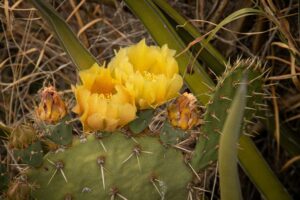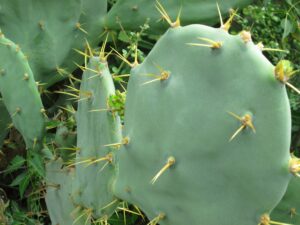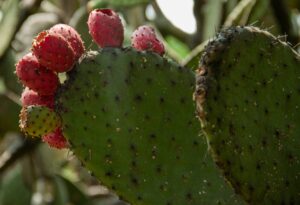Eastern Prickly Pear Cactus (Opuntia humifusa)

When I think of plants that are native to many northern states – and thrive – I admit that a cactus never crosses my mind. But in many of our northern states, we do have a cactus that grows well – Prickly Pear Cactus. This genus of cactus (Opuntia) is native in many states east of the Rockies – plus parts of Oregon. If you have a garden of only plants native to your area, check with your state to see if Opuntia is native and if it is, which species? There are several that are native to North America. the most common and widespread is Opuntia humifusa – Eastern Prickly Pear – which is the one I will discuss here. All of the other species of Opuntia have the same general growing requirements.
Prickly Pear is like many cacti in that it does not have traditional stems and leaves but is composed of flat, curved, segments that have spines and bristles.
- – Light: Full sun.
- – Soil and water: Average garden soil and the site must be well drained. It will grow in sandier soils. Avoid heavy clay. Once

Some flowers will be golden yellow, but they can also have this lovely reddish-orange shading. These flowers will be followed by red fruits. Photo by Melody Arnold. established, do not water.
- – Hardiness Zone: Zone 4-9.
- – Size: About 6-10 inches tall but will slowly grow increasingly wider until it becomes a dense groundcover.
- – Bloom period and color. Deadheading: Large yellow flowers – sometimes with reddish orange shadings. These flowers bloom along the edge of the pads. Once the plant is established, it can be filled with blooms. Each flower only lasts about one day, but they bloom one right after the other and so you will have flowers for about 3-4 weeks in June-July. There is no need to deadhead these flowers. After flowering, the plant produces fairly large, reddish fruits.
- – Insects, butterflies, and birds: All pollinating insects love Prickly Pear Cactus – most particularly native bees.
- – Deer, rabbits, and other pests: Those spines are great deterrents. Deer and rabbits avoid this cactus. These plants are generally disease free.
- Propagating and transplanting. How to work with this plant and not get stuck yourself: As long as you protect yourself from the spines – read on for more about that – this plant is fairly easy to transplant. It has a smaller and shallower root system. Dig it out first so you can see just what size hole is necessary. Do not plant it deeper than it was.
- Prickly Pear is easy to propagate. Break off a segment where it joins the plant any time during the growing season and stick that end into the ground. Water sparingly. It will take several weeks to begin rooting.


How do you care for a plant that seems ready to give you a good jab if you get too close? Before planting Prickly Pear, eliminate all weeds from the immediate and surrounding area with one of these methods: use a weedkiller before planting the cactus, dig out every weed (and all their roots!) by hand, or cover the area with thick sheets of newspaper or plastic weighted down with rocks or bricks for at least 2 months.
When working close to or with Prickly Pear, wear gloves – I use gloves made for working with roses. Weeds can be an issue with this plant – you must be vigilant and check it every 2 weeks so you can use long-handled tweezers to pull out any that emerge while they are young and easily pulled. If you are not an organic gardener, once you get the cactus into the ground, use a pre-emergent around the plant to prevent weed seeds from germinating – follow the directions on the container. If weeds appear, a weed killer can be used but instead of spraying, wear rubber gloves – or their equivalent – and use a long handled artist’s brush and paint the weed leaves with the weed killer.
Is this plant worth all the effort? I think so – I have two in my garden. I do grow mine organically. I eliminated all weeds before planting and check them every two weeks and pull any young weeds at that time. (Note: Applications of a pre-emergent at the proper times – follow the directions on the label – and using a paintbrush to apply weed killer exactly where it is needed should greatly reduce/eliminate harm to pollinators.)
What to plant with Prickly Pear?: I think there are 3 plants that will go well with Prickly Pear Cactus, but it will depend on how much room you have as these are all good-sized to big plants. But all thrive in hotter, drier beds. If you have a large area that is too hot and dry for most plants, including grass, try creating a flower bed with these 3: Yucca (Yucca filamentosa), Rattlesnake Master (Eryngium yuccifolium), and Prickly Pear Cactus. Plants from the Sedum family (Hylotelephium) can be added for additional color and texture – ‘Autumn Joy’ or ‘Purple Emperor’ would be good choices. And even though all these plants require less than an average amount of water, when you are finished planting, mulch the bed. Mulch will help conserve the water that is in the soil plus cut down on weeding. Mulch always gives your beds a ‘finished’ look. Keeps them looking neat and tidy – of course you will still have to check regularly for weeds and pull them out.
When I drive around looking at people’s gardens, I see quite a bit of Yucca. If you have Yucca (native to our southeastern states), consider widening its bed and adding Rattlesnake Master and Prickly Pear Cactus. All like the same growing conditions and all bloom just about the same time. The Yucca is the tallest, Rattlesnake Master is next, and Prickly Pear is the shortest. All these plants are wide and so will need room to spread out.
Prickly Pear is also a good choice for under the eaves of your house, garage, shed, or any building – always a hard area to keep watered. Just make sure the plants will get about 6 hours of sun each day. You can also use this plant as a barrier to rabbits and squirrels – a ‘wall’ of protection for vulnerable plants. Those spines will deter any small to medium-sized mammal.

